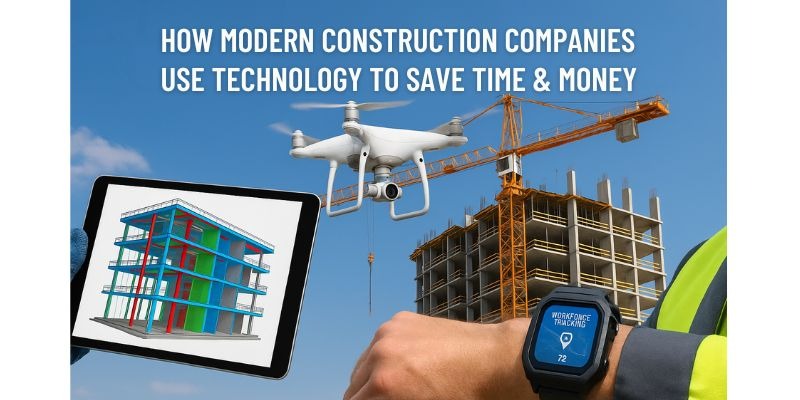How Modern Construction Firms Use Technology to Save Time & Money

Today’s builders combine craftsmanship with high-tech ways of doing things, with the intent of compressing timelines, reducing waste leading higher-quality projects. Be it residential remodelling, commercial development, or large-scale infrastructure, technology is beginning to play an ever-important role, literally, in every phase of construction.
Look to any successful construction company in St Louis today, and one thing becomes self-evident right off the bat: gone are the days of the industry relying exclusively upon traditional tools and manual processes.
Modern contractors build efficiencies, not just structures. Below is an in-depth look at technology-driven strategies that save companies time and money while improving customer satisfaction.
1. Digital Blueprints & BIM: Putting an End to Costly Design Errors
Construction drawings have traditionally been printed out onto sheets and reviewed manually-a process infamous for misinterpretation, missing information, or extremely costly mistakes found too late.
Today, BIM has revolutionised the manner in which the entire design and pre-construction process is envisioned.
How BIM Saves Time & Money
- Instant 3D visualisation clearly explains designs to clients.
- Clash detection allows for finding the structural, mechanical, and electrical conflicts before commencing the work.
- Fewer change orders, which means fewer delays.
- Accurate material estimates avoid overspending and waste.
BIM enables architects, engineers, and contractors to work on the very same digital model, hence avoiding confusion and making collaboration smoother.
2. Drones: Faster Site Surveys & Safer Inspections
Drone technology has rapidly become one of the most valuable tools on the modern jobsite. Rather than taking days to survey a large property or climbing hazardous structures, drones capture high-resolution data in minutes.
Advantages of Using Drones
- Faster surveys of large construction sites.
- Safer roof, tower, trench, and high-hazard area inspections.
- Timely and accurate monitoring of progress through aerial imagery, either on a weekly or monthly basis.
- It provides real-time data used for planning and documentation of compliance.
They significantly reduce labour costs through the saving of time used in surveying and the elimination of risks associated with manual inspection.
3. Project Management Software: Keeping Teams Aligned
A construction project involves a great number of stakeholders: subcontractors, suppliers, project managers, and clients. The absence or even delay of information can delay the most straightforward project.
Modern project management tools like Procore, Buildertrend, CoConstruct, and Monday.com keep everything in order.
How Project Management Tools Improve Efficiency
- Real-time scheduling and resource allocation
- Instant Approvals of Change Orders
- Automated progress reports
- Centralized communication
These tools prevent misunderstandings, reduce the number of back-and-forth phone calls, and keep teams on budget. To a growing construction company, software is no longer optional; it’s necessary.
4. Prefabrication & Modular Construction: Speeding Up Build Times
One huge game-changer in construction has to be the rise in prefabricated and modular building methods. Instead of building everything on-site, companies manufacture components in controlled warehouse environments.
Why Prefabrication Saves Time & Money
- Decreased labour hours on site
- Delays because of the weather are fewer.
- Improved Quality Control
- Faster installation and assembly
- Less material waste
Commercial projects built using modular construction methods can save anywhere from 20-50% of the total build time. That means quicker move-ins and lower project costs to the homeowner.
5. Robotics & Automation: Reducing Manual Labour Costs
That might sound futuristic, but robotics is already becoming common in the world of construction. Such automated tools do well with repetitive or labour-intensive tasks, hence improving safety and precision.
Examples of Robotics in Construction
- Bricklaying robots lay bricks at much higher speeds.
- Rebar-tying robots save hours of manual labour.
- Consistent results with flooring installation systems.
- Autonomous vehicles transporting materials on large sites.
Automation replaces nothing but your hard work, enables you to concentrate on skilled activities and decreases fatigue and injury.
6. 3D Printing: Quick and Affordable Builds
3D printing of construction is no longer experimental. A number of companies in the U.S. are now building 3D-printed homes in a fraction of the time of traditional construction.
Advantages of 3D Printing
- Reduced material use
- Reduced Labour requirements
- High structural accuracy
- Fast build times
3D printing reduces labour and material costs for construction firms while producing very consistent results. It is the most promising technology that will shape the future of the industry.
7. Smart Tools & IoT Sensors
Prevent Costly Mistakes IoT devices monitor equipment, track progress, and ensure job site safety, while a suite of connected sensors collect real-time data for project leaders to use to prevent mistakes before they happen.
Examples of IoT in Construction
- Equipment trackers that reduce theft and improve usage.
- Concrete sensors that can monitor curing time precisely.
- Structural sensors detect weakness or movement.
- Wearable devices that ensure workers’ safety.
Real-time data supports faster decision-making by contractors, enabling them to avoid costly reworks.
8. Virtual Reality & Augmented Reality:
Better Planning & Fewer Surprises. VR and AR give the clients a chance to view results even before actually beginning the work. This will prevent misunderstandings and ensure the satisfaction of the client.
Uses of VR/AR
- VR/AR is useful for walking through the finished structure before actual construction.
- Identify layout and design issues beforehand.
- Training employees through the use of immersive simulations.
- Improve on-site decision-making.
VR-based design reviews drastically reduce revisions, shaving off weeks from the project timeline.
9. GPS & Telematics
Efficient Equipment Management Heavy machinery costs a fortune to keep working and even more to replace. Using GPS tracking and telematics, construction companies can monitor the performance in real time of their equipment at work.
Why GPS is a necessity today:
- Tracking of fuel consumption and reducing wastage.
- Optimisation of routes that have to be taken during material delivery.
- Prevention of unauthorised usage of equipment.
- Extending the lifespan of machinery by performing routine maintenance.
For any construction company, effective management of equipment just means saving a fortune.
Conclusion
Technology is building the future of construction. No longer merely an add-on, technology provides the very foundation upon which construction operates today. From drones and robotics to 3D printing and IoT sensors, the innovations of today equip builders to reduce waste, avoid delays, and enhance project outcomes.
Embracing innovation doesn’t just help companies build faster-it helps them build smarter. And in an industry where literally every hour and every dollar counts, technology is truly the key to saving both time and money.




